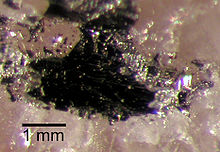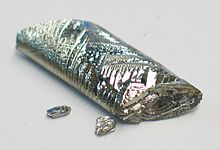Tellurium
tellurium or tellurium (from the Latin tellus, 'Earth') is a chemical element whose symbol is Te and its atomic number is 52. It is a semimetal that is in group 16 and period 5 of the periodic table of elements.
It was discovered in 1782 in gold ores by Franz-Joseph Müller von Reichenstein, chief inspector of mines in Transylvania (Romania), calling it metallum problematicum. At first tellurium was confused with antimony. It was Martin Heinrich Klaproth, in 1798, who examined Müller's "problem metal" and named it tellurium.
Tellurium is a relatively stable element, insoluble in water and hydrochloric acid, but soluble in nitric acid and aqua regia. Reacts with excess chlorine to form telluride dichloride, TeCl2 and tellurium tetrachloride, TeCl4. It is oxidized with nitric acid to give tellurium dioxide, TeO2, and with chromic acid to give telluric acid, H2TeO4. In combination with hydrogen and certain metals, it forms tellurides, such as hydrogen telluride, H2Te, and sodium telluride, Na2Te. Tellurium has a melting point of 452 °C, a boiling point of 990 °C, and a relative density of 6.25. Its atomic mass is 127.60. [citation required]
Tellurium compounds are widely used in synthetic organic chemistry for reduction and oxidation, cyclofunctionalization, dehalogenation, carbanion generation reactions, and removal of protecting groups. Organometallic compounds are intermediates in the synthesis of amines, diols, and natural products. Tellurium is a key component of high performance mixed oxide catalysts for the heterogeneous catalytic selective oxidation of propane to acrylic acid. In the presence of steam, the catalyst surface is enriched in tellurium and vanadium resulting in improved production of acrylic acid. Tellurium can be used in ammonia sensors and tellurite crystals.
Features
Physical properties
Tellurium has two allotropes, crystalline and amorphous. When crystallized, tellurium is silvery white with a metallic luster. The crystals are trigonal and chiral (space group 152 or 154 depending on chirality), like the gray form of selenium. It is a brittle and easily pulverized metalloid. Amorphous tellurium is a black-brown powder that is prepared by precipitating it from a solution of telluric acid or telluric acid (Te(OH)6). Tellurium is a semiconductor that shows increased conductivity electric in certain directions depending on atomic alignment; conductivity increases slightly when exposed to light (photoconductivity). When molten, tellurium is corrosive to copper, iron, and steel. Of the elements in the oxygen family, tellurium has the highest melting and boiling points, at 722.66 Kelvin (449.5 °C) and 1,261 Kelvin (987.9 °C) respectively.
Chemical Properties
Crystalline tellurium consists of parallel helical chains of Te atoms, with three atoms per turn. This gray material resists oxidation by air and is non-volatile.
Isotopes
29 tellurium isotopes are known, with atomic masses ranging from 108 to 137. There are 8 tellurium isotopes in nature, three of which are radioactive. 128Te has the longest known half-life of all tellurium radioisotopes (2.2·1024 years). Tellurium is the element with the lowest atomic number that can undergo alpha decay. With isotopes from 106Te to 110Te, you can experience this type of decay.
Abundance and obtaining
Tellurium can be obtained combined with gold in skullite, a relatively rare metallic mineral. [citation required]
In April 2017, the discovery of the largest tellurium deposit in the world was published, in the waters of the Canary Islands (Spain), in the seamounts located within the Canarian waters called "the grandmothers of the Canary Islands" (Drago, Bimbache, Ico, Pelicar, Malpaso, Tortuga and Infinito and Las Abuelas). The deposit is estimated to have a total of about 2,670 tons of tellurium, some 50,000 times more than the largest find found so far.
Cadmium Telluride
Cadmium telluride (CdTe) is a crystalline compound formed by cadmium and tellurium. It is used as an infrared optical window and as a solar cell material. It is usually intercalated with cadmium sulfide to form a pn junction photovoltaic cell. Normally, CdTe cells use an n-i-p structure.
History
Tellurium ([from [Latin]] tellus, meaning "earth") was discovered in the 18th century XVIII into a gold ore from the mines at Kleinschlatten (now Zlatna), near the present-day city of Alba Iulia, Romania. This mineral was known as "Faczebajer weißes blättriges Golderz" (leafy white gold ore from Faczebaja, German name for the town Facebánya, now Fața Băii in Alba County) or antimonalischer Goldkies (antimonous gold pyrite), and according to Anton von Rupprecht, was Spießglaskönig (argent molybdique), which contained native antimony. In 1782 Franz-Joseph Müller von Reichenstein, then Austria's chief inspector of mines in Transylvania, concluded that the ore it did not contain antimony but was bismuth sulphide. The following year, he reported that this was erroneous and that the ore contained mainly gold and an unknown metal very similar to antimony. After exhaustive research that lasted three years and included more than fifty tests, Müller determined the relative density of the mineral and noted that when heated, the new metal emits white smoke with a horseradish-like odor; which imparts a red color to sulfuric acid; and that when this solution is diluted with water, it has a black precipitate. However, he was unable to identify this metal and gave it the names aurum paradoxum (paradoxical gold) and metallum problematicum (problem metal), because it did not exhibit the properties predicted for gold. antimony.
Applications
The largest consumer of tellurium is metallurgy in iron, stainless steel, copper and lead alloys. The addition of steel and copper produces a more machinable alloy. It is alloyed in cast iron to promote cooling for spectroscopy, where the presence of free, electrically conductive graphite tends to interfere with spark emission test results. Tellurium decreases the corrosive action of sulfuric acid and improves the strength and durability of lead alloys.
Heterogeneous catalysis
Tellurium oxides are components of commercial oxidation catalysts. Catalysts containing Te are used for the ammoxidation pathway to acrylonitrile (CH2=CH–C≡N):
- 2 CH3−CH=CH2 + 2 NH3 + 3 O2 → 2 CH2=CH–C≡N + 6 H2O
Related catalysts are used in the production of tetramethylene glycol:
- CH3CH2CH2CH3 + O2 → HOCH2CH2CH2CH2OH
Niches
- The vulcanized synthetic rubber with telury shows mechanical and thermal properties that, in a way, are superior to sulfur vulcanized materials.
- Telury compounds are specialized pigments for ceramics.
- Seleniuros and telurides greatly increase the optical refraction of the glass widely used in optical fibers for telecommunications.
- Selenium and telury mixtures are used with barium peroxide as oxidant in the retardant powder of electric detonators.
- Telury neutron bombing is the most common way to produce iodine-131. This, in turn, is used to treat some thyroid conditions and as a tracer compound in the hydraulic fracture, among other applications.
Semiconductor and electronics
Due to its low electronegativity, tellurium forms a variety of materials with small bandgaps, which are amenable to relatively long-wavelength light. This characteristic is the basis of possible applications in photoconductive materials, solar cells and infrared detectors. The main concern holding back some applications is the modest stability of these materials and concerns about environmental impact.
Cadmium telluride (CdTe) photovoltaic modules exhibit one of the highest efficiencies for solar cell electric power generators.
X-ray detectors based on cadmium telluride and zinc (Cd,Zn)Te have been demonstrated.
Mercury cadmium telluride (HgCdTe) is a semiconductor material that is sensitive to infrared radiation.
Organotellurium Compounds
Organotellurium compounds are primarily of interest in the research context. Several such metal-organic vapor phase epitaxial growth precursors of II-VI semiconductor compounds have been investigated. These precursor compounds include dimethyl telluride, diethyl telluride, diisopropyl telluride, diallyl telluride, and methyl-allyl telluride. Diisopropyl telluride (DIPTe) is the preferred precursor for low-temperature growth of CdHgTe by MOVPE. In these processes, the highest purity organic metals of both selenium and tellurium are used. Compounds for the semiconductor industry and are prepared by adduct purification.
Tellurium suboxide is used in the carrier layer of rewritable optical discs, including rewritable Compact Discs (CD-RWs), rewritable digital video discs (DVD-RWs), and rewritable Blu-ray discs.
Tellurium dioxide is used to create acousto-optic modulators (AOTFs and AOBSs) for confocal microscopy.
Telluride is used in phase change memory chips developed by Intel. Bismuth telluride (Bi2Te3) and lead are part of the operating elements of thermoelectric devices. Lead telluride seems to have interesting properties for use in infrared detectors.
Photocathodes
Tellurium is used in various photocathodes in solar blind photomultiplier tubes and for high-brightness photoinjectors that are part of modern accelerators. The Cs-Te photocathode, which is predominantly Cs2Te, has a photoemission threshold of 3.5 eV and exhibits the uncommon combination of high quantum efficiency (>10%) and high durability in poor vacuum. environments (lasting for months under use in RF electron guns). This has made it the choice for photoemission electron guns used in driving free-electron lasers. In this application, it is typically actuated at the length of wave 267 nm, which is the third harmonic of Ti-sapphire lasers in common use. More Te-containing photocathodes have been grown using other alkali metals such as rubidium, potassium, and sodium, but have not met with the same popularity as Cs-Te.
Thermoelectric material
Tellurium itself can be used as a high-performance elemental thermoelectric material. A trigonal Tee with the space group of P3121 can be transferred to a topological insulating phase, which is suitable for thermoelectric material. Although not often considered as a thermoelectric material alone, polycrystalline tellurium shows great thermoelectric performance with a thermoelectric figure of merit, zT, as high as 1.0, which is even higher than some other conventional TE materials such as SiGe and BiSb.
Contenido relacionado
Dubnium
Natron
Butane



